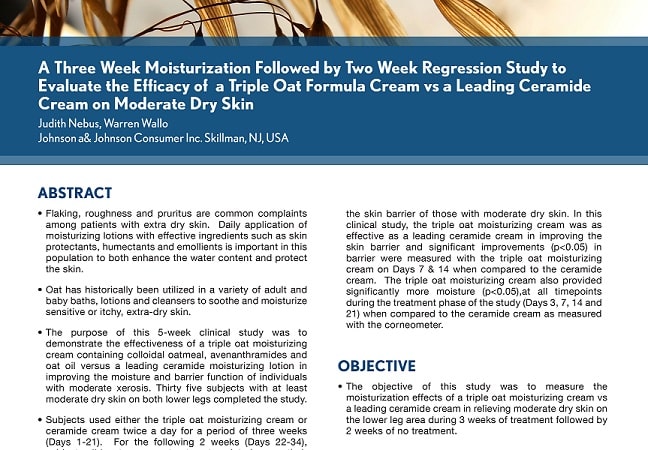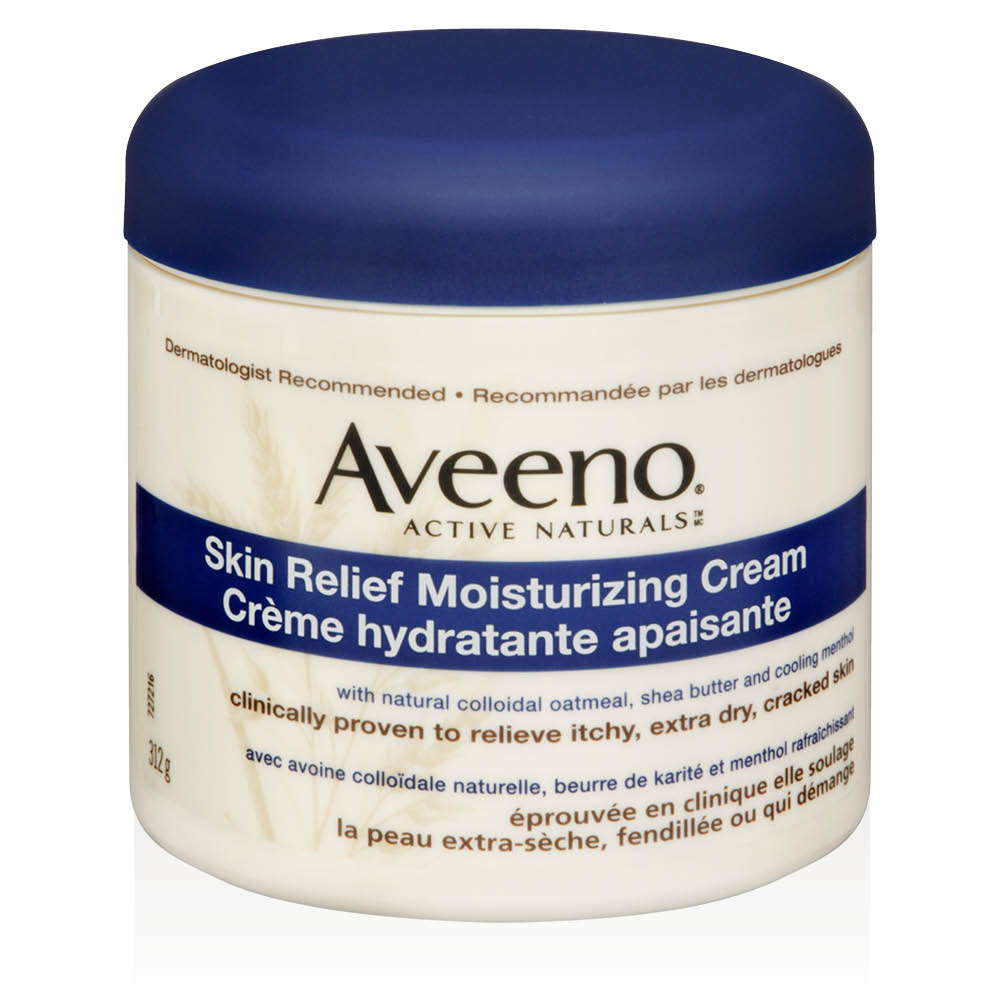A Three Week Moisturization Followed by Two Week Regression Study to Evaluate the Efficacy of a Triple Oat Formula Cream vs a Leading Ceramide Cream on Moderate Dry Skin
Judith Nebus, Warren Wallo
Johnson & Johnson Consumer Inc. Skillman, NJ, USA
Abstract
Flaking, roughness and pruritus are common complaints among patients with extra dry skin. Daily application of moisturizing lotions with effective ingredients such as skin protectants, humectants and emollients is important in this population to both enhance the water content and protect the skin.
- Oat has historically been utilized in a variety of adult and baby baths, lotions and cleansers to soothe and moisturize sensitive or itchy, extra-dry skin.
- The purpose of this 5-week clinical study was to demonstrate the effectiveness of a triple oat moisturizing cream containing colloidal oatmeal, avenanthramides and oat oil versus a leading ceramide moisturizing lotion in improving the moisture and barrier function of individuals with moderate xerosis. Thirty-five subjects with at least moderate dry skin on both lower legs completed the study.
- Subjects used either the triple oat moisturizing cream or ceramide cream twice a day for a period of three weeks (Days 1-21). For the following 2 weeks (Days 22-34), subjects did not use any treatment moisturizer on their legs.
- Transepidermal water loss and moisturization measurements were obtained 9 times during the study. Transepidermal water loss measurements showed significant improvements (p<0.05) in skin barrier at all times points during the treatment phase of the study (Days 3, 7, 14, 21) for both products and during the regression phase (Days 28, 30, 35). The triple oat moisturizing cream group demonstrated significant improvements (p<0.05) in skin barrier when compared to the ceramide cream treated group on Days 7 and 14.
- Moisturization measurements (corneometer) showed a significant increase (p<0.05) in skin hydration at all time points during the treatment phase of the study (Days 3, 7, 14, 21) for both products. During the 2-week regression phase (no treatment) a significant improvement (p<0.05) in skin hydration was still noted at all five-time points measured (Days 22, 24, 28, 30 and 35). The triple oat moisturizing cream was significantly better (p<0.05) than the ceramide cream in increasing skin hydration at all time points in the treatment phase (Day 3, 7, 14 and 21).
- Clinical evaluations for roughness showed significant decreases in roughness from baseline at all time points during the treatment phase of the study (Days 3, 7, 14, 21) for both products and during the regression phase (Days 22, 24,28, 30, 35).
- In conclusion, this triple oat moisturizing cream was highly effective in providing intense moisturization and improving the skin barrier of those with moderate dry skin. In this clinical study, the triple oat moisturizing cream was as effective as a leading ceramide cream in improving the skin barrier and significant improvements (p<0.05) in barrier were measured with the triple oat moisturizing cream on Days 7 & 14 when compared to the ceramide cream. The triple oat moisturizing cream also provided significantly more moisture (p<0.05), at all timepoints during the treatment phase of the study (Days 3, 7, 14 and 21) when compared to the ceramide cream as measured with the corneometer.
Objective
The objective of this study was to measure the moisturization effects of a triple oat moisturizing cream vs a leading ceramide cream in relieving moderate dry skin on the lower leg area during 3 weeks of treatment followed by 2 weeks of no treatment.
Study Design
- This was an investigator-blinded study at an independent research laboratory. IRB approval was obtained prior to study initiation. Each subject used the triple oat moisturizing cream and the ceramide cream on the appropriate lower leg according to the randomization schedule, twice a day for a period of three weeks (Days 1-21). For the following 2 weeks (Days 22-35), subjects did not use any treatment moisturizer on their legs. A within statistical analysis of data was performed to determine regimen efficacy.
- Evaluations - Clinical Evaluations: Roughness & Dryness (Days 0, 3, 7, 14, 21,22, 24, 28, 30, 35); Instrumental: TEWL (barrier) & Corneometer (moisture) (Days 0, 3, 7, 14, 21, 22, 24, 28, 30, 35).
- Population - 35 subjects completed the study. Subjects were female, between the ages of 18-65 years old, with at least moderate dry skin on both lower legs. There was a 5-day conditioning period prior to the baseline visit. Subjects were prohibited from shaving 48 hours prior to evaluation or using any product on the lower leg area except the test products and the provided cleanser. No product related A/ Es were reported at any time during the study.
- Statistical Analysis - Within treatment analysis for the expert grader assessment scores were conducted using Wilcoxon’s signed rank test at each time point. The within-treatment analysis for TEWL and Corneometer scores were conducted using Student’s t-test for paired data.
Results
8.4_figure_1.jpg
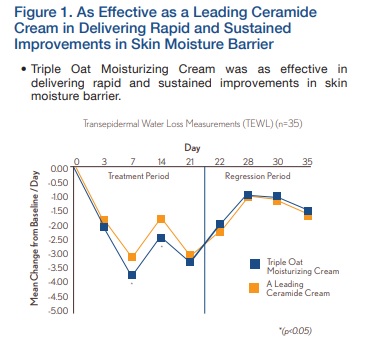
8.4_figure_2.jpg
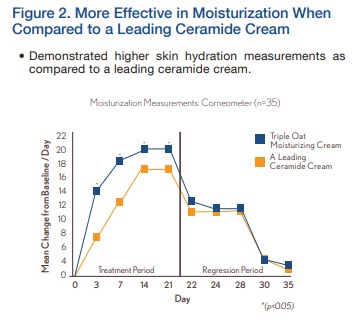
8.4_figure_3.jpg
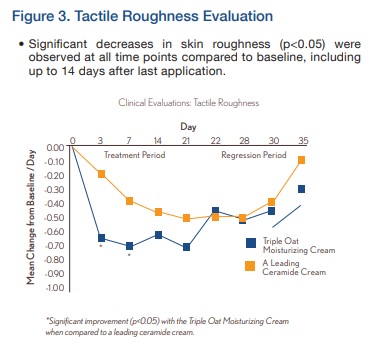
Conclusions
This study demonstrated that the triple oat moisturizing cream was effective in maintaining a healthy moisture barrier with improvements in TEWL, moisturization and tactile roughness of individuals with moderate dry skin.
Overall, the triple oat moisturizing cream demonstrated excellent benefits in alleviating dry skin. In addition, it outperformed a leading ceramide cream in skin hydration measurements (corneometer) at all time points during the treatment phase of this study.
- Both creams were well tolerated and efficacious in moisturizing moderate dry skin.
- The triple oat moisturizing cream was as effective as a leading ceramide cream in delivering rapid and sustained improvements in skin barrier, as evidenced by TEWL measurements during treatment and regression.
- The triple oat moisturizing cream demonstrated better efficacy in moisturization when compared to a leading ceramide cream, as seen in the skin hydration measurements during the treatment phase of the study.
Acknowledgements
Hill Top Research, Winnipeg, Canada

